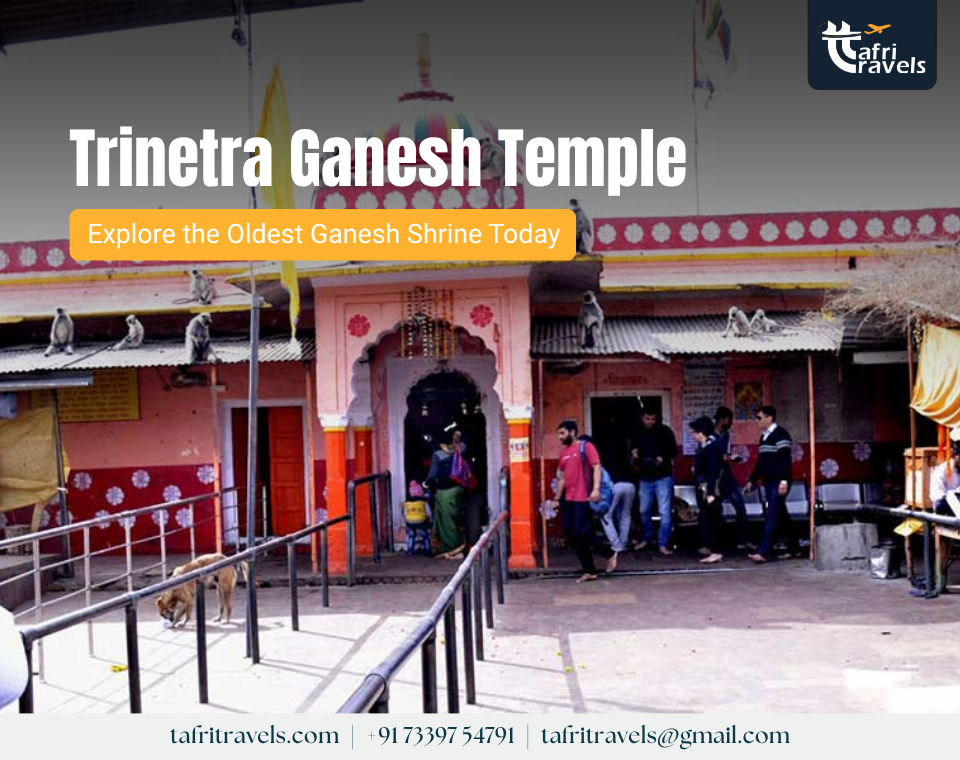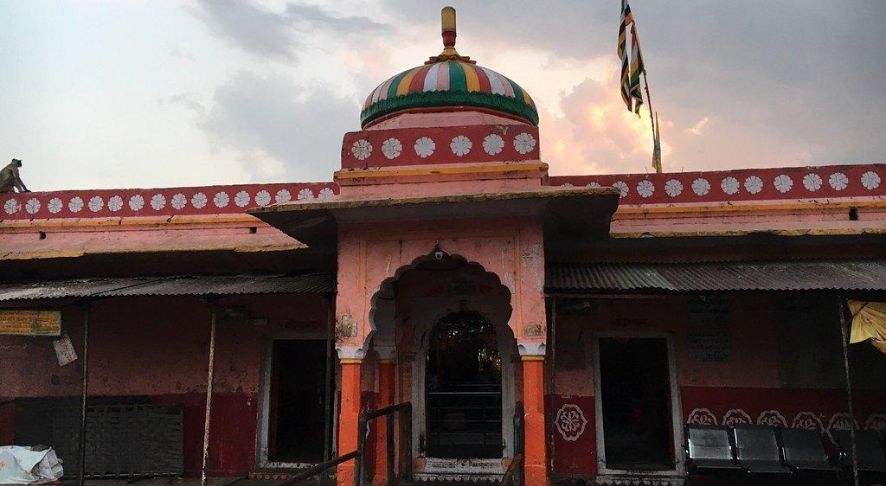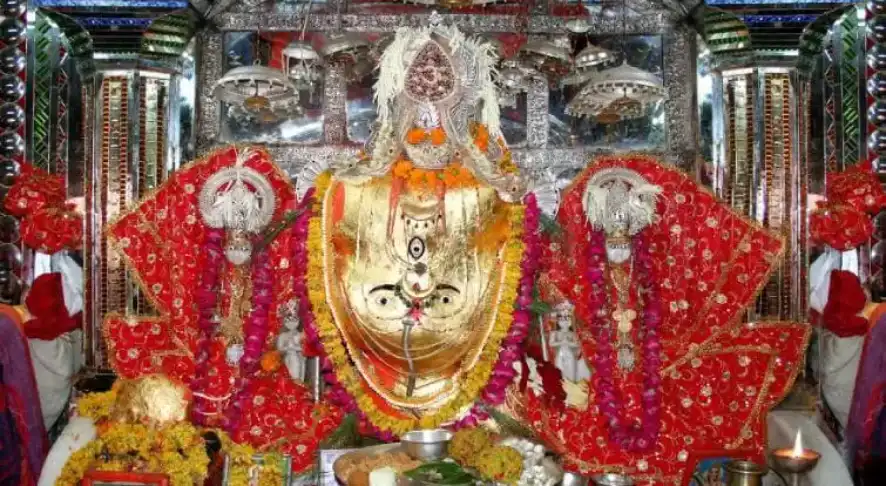
Trinetra Ganesh Temple – Explore the Oldest Ganesh Shrine Today
The Trinetra Ganesh Temple inside Ranthambore Fort in Rajasthan is considered one of India’s oldest and most respected Ganesha places of worship. It stands apart by having Lord Ganesha in his entire family form. “Trinetra” represents three eyes, that of a deity who sees all things. Pilgrims and tourists visit the Trinetra Ganesh Temple during Ganesh Chaturthi, believing that offering prayers makes wishes come true.
Table of Contents
ToggleSacred History of Trinetra Ganesh Temple

The Trinetra Ganesh Temple, which is found inside the Ranthambore Fort in Rajasthan, has stayed in place for over 800 years. The strained war between Alauddin Khilji and King Hammirdev Chauhan deeply disturbed the king. That night, in his dream, he saw lord ganesha encouraging him. Then, the next morning, Lord Ganesha with three eyes and his family appeared on the wall of the fort. The king considered the incident to be a blessing from Ganesha and so decided to build a temple at that very spot.
The sacred ritual of the temple is that Lord Ganesha, his wives Riddhi and Siddhi, and his sons Shubh Labh are all worshipped together daily with soothing aartis and sweets.
Nowadays, thousands come to Trinetra Ganesh Temple to honor their faith, seek hope, and learn about their heritage.
Explore the Wild: Top Places to Visit in Sawai Madhopur in 2025
Spiritual Importance of Trinetra Ganesh Temple

The miraculous Trinetra Ganesh temple holds importance in the hearts of people and its devotees:
- Religious Beliefs and Rituals: Hindus consider the Trinetra Ganesh Temple to be a strong example of devoted worship. Believers think that when a person offers sincere prayers here, it can remove all obstacles and help them succeed. People seek Lord Ganesha’s blessings for new experiences like marriage and business by offering prayers, modaks (sweet offerings) and inviting him to their weddings.
- Trenetra (Third Eye): Lord Ganesha is often called Trinetra or the one with three eyes, after his divine vision. It represents being wise, aware and able to notice things that other people miss. Many believe it defends them from bad luck, guides them in the right direction, and brings them closer to God.
- Devotees’ Faith and Experiences: During Ganesh Chaturthi, the number of worshippers at this temple increases greatly. Lots of visitors tell of how their prayers were granted once in this temple.
Adventure Awaits: Complete Ranthambore Safari & Wildlife Guide 2025
Things to know before visiting
Here are some things that you need to know concerning Lord Ganesha and this spiritual place:
- Wear comfortable shoes, as it is to be reached after a short uphill trek.
- Wear clothes respectfully to maintain the temple’s spirituality and sanctity.
- Always keep water with you.
- Be aware of Monkeys, they can snatch your food and any essentials.
- Purchase your crucial items before visiting, as the temple has no shops.
- The temple prohibits photography inside, as it can disturb devotees.
Best Time to Visit
The season of winters, from October to March, naturally enhances Trinetra Ganesh Temple’s beauty with its pleasant weather with clean and cozy trekking paths. Don’t plan a visit to Temple during April, May, or June because of the hot summer weather. Ganesh Chaturthi is the best time to come for a festive atmosphere, but the crowds can be hard to handle.
Explore More: Ranthambore Fort Timings, Tickets & What to See Inside
Time of visit to a Trinetra Ganesh Temple
Lord Ganesh Temple opens at 6:30 AM during Prabhat aarti in the early morning with a serene ambience and closes at 8:00 PM after the Shayan aarti. Several Aartis have been held in the temple at different hours. It remains accessible on all days of the week.
Entry fees to the Trinetra Ganesh Temple
Temple itself has no entry fees, but as it is in a fort, you have to pay the fort’s entry fees:
- Indian Nationals: ₹15 per person.
- Foreign Nationals: ₹200 per person.
- Indian Kids: ₹10 per person.
- Using Video cameras is chargeable inside the fort.
- Still photo cameras are free.
Explore & Learn: Rajiv Gandhi Regional Museum of Natural History Tips
How to Reach and Location
The Trinetra Ganesha Temple stands in Sawai Madhopur district of Rajasthan, India, near the famous Ranthambore National Wildlife Park.. Its prominent location made it the most visited place, with various means of transportation:
By Bus: Buses from Kota, Jaipur, and neighbouring places are available to reach Sawai Madhopur. Auto rickshaws, taxis, and local buses can be found at the bus station to take you to Ranthambore Fort.
By Train: The temple is only 11 km away from Sawai Madhopur Junction Station. The Sawai Madhopur station connects major cities, and autos or taxis take you to the fort from the railway station.
By Flight: You can reach Jaipur International Airport, which is 160 km from the city. Next, you could hire a taxi or take a bus or train to Sawai Madhopur, which will take about 4 hours.c
Frequently Asked Questions
1. What is the history of Trinetra Ganesha Temple?
Ans: King Hammirdev Chauhan built it after Lord Ganesha appeared to him in a dream during a war in the 13th century.
2. How many stairs are in Trinetra Ganesh Temple Ranthambore?
Ans: There are around 250 to 300 stairs leading up to the temple inside Ranthambore Fort.
3. What are the timings of Trinetra Ganesh Temple Ranthambore?
Ans: The temple is open daily from 6:30 AM to 8:00 PM.
4. What is the significance of Trinetra Ganesh Temple Ranthambore?
Ans: Devotees worship Lord Ganesha with his full family—Riddhi, Siddhi, Shubh, and Labh—only at this temple.
5. How far is the trek to Ranthambore Ganesh Temple?
Ans: The trek is about 1 to 1.5 km uphill and takes 20–30 minutes.
6. Where is Trinetra Ganesh Temple located?
Ans: It’s located inside Ranthambore Fort in Sawai Madhopur, Rajasthan.
7. Can we drive up to Trinetra Ganesh Temple?
Ans: No, vehicles aren’t allowed. Visitors must walk from the fort parking area.
